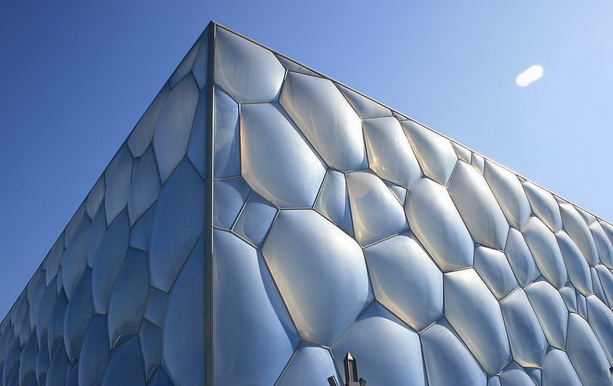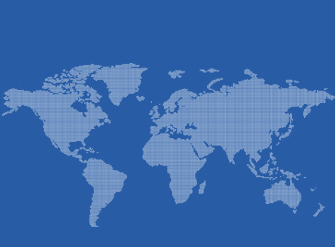
ETFE is the abbreviation of EthyleneFetraFluoroEthylene, Chinese name is called ethylene matters fluorine ethylene copolymer. ETFE is a colorless, transparent granular crystal with excellent abrasion resistance and abrasion resistance, high temperature resistance, corrosion resistance and good insulation performance. It can be used as a cable sheath or pipe protector. ETFE film used in construction engineering is a film made of raw materials, usually of thickness 0. 05 ~ 0. 25mm, very strong and durable, with extremely high transmittance. The 2008 Olympic Games in Beijing national stadium, the stadium and other venues have adopted the membrane material, therefore, in this paper, the material properties of ETFE membrane, the membrane structure engineering the application form, the working principle of ETFE cushions, membrane material connection methods, introduce the foreign typical engineering.

1. Material properties of ETFE film.
1.1 The basic mechanical properties of ETFE film
1) Thickness and quality of
The thickness of ETFE film is usually 0. 05 ~ 0. 25 mm. As the thickness increases, the film material will be harder and more brittle, difficult to process. ETFE has a density of about 1. 75 g/cm. For example, 0.20mm thick ETFE film material is about 350g/m2.
2) Tensile strength
The tensile strength of ETFE film is greater than 40MPa.
3) Strain relationship
Under normal temperature, the ETFE film is fully elastic and the tensile modulus reaches 800 ~ 1000MPa under 20MPa. When tensile stress occurs near 25MPa, the yield point will appear and then enter the plastic strengthening stage until the fracture is broken.
4) Breaking elongation
The breaking elongation of ETFE film is more than 300%.
1.2 Other properties of ETFE film
1) Durability
ETFE film material has excellent anti-aging ability, with a life span of more than 25 years.
2) Color and transmittance
ETFE film is usually colorless and transparent and can be made white. Various patterns can be printed on transparent or white film materials as needed. In order to 0. For example, 20mm thick ETFE film material, the transmittance of single layer transparent membrane material is as high as 95%, and the white film material is 50% ~ 55%. Using white film material or printing different colors and patterns on transparent film, the light can be adjusted into the building.
3) Fire resistance
ETFE is a flame retardant material. Even in the flame, the ETFE film will contract after the hot melt, but no drop. Because the ETFE film is very thin and light, in case of fire, it is less harmful.
4) Self-cleaning performance
ETFE film surface is very smooth and has excellent self-cleaning properties. Dust and dirt can be removed from the membrane structure of ETFE film. The appearance of the manual cleaning is usually four years.
5) Climate adaptation
ETFE materials working temperature range for the 200 ~ 150 ℃; Material melting point is 275 ℃ or so. ETFE film has excellent stability and climate adaptability. The practice shows that the mechanical and optical properties of ETFE films, which are exposed to severe weather conditions for more than 15 years, have not changed. In the hailstorm area, even though the roof of the glass was smashed by hailstones, there were only small dents in the ETFE roof.
6) Anti-tear resistance, flexibility and machinability
ETFE film has good tear resistance, flexibility and machinability.
7) The recyclable ETFE film can be melted into granules and reintegrated.
1. Application form of ETFE film
2.1. Single layer tensioned
ETFE film can be used in the membrane structure as PVC film or PTFE film. Although the tensile strength of ETFE materials itself is not low, but because of the membrane material made of very thin (less than 1/5 of the fabric type of membrane material thickness), thus ETFE to monolayer tensioning method was applied to membrane structure, the span of structure than the fabric type of the structure of the membrane material is small.
2.2 Double layer or multilayer air cushion type
ETFE materials are often make double layer or multilayer air cushion type and used in the membrane structure, the ETFE materials according to the design of the shape and the layer number of cutting, stitching together, to the air as a cushion between the layers. The shape of the air cushion can be round, oval, triangular, rectangular, hexagon or any other shape. Through aluminum alloy frame or cable network to connect multiple air cushion together, can make up a large coverage space.
3 ETFE air cushion work principle
3. 1 The role of air in the ETFE air cushion
In ETFE air cushion, the air is mainly used as follows:
1) Stabilizing effect. Air in the air cushion creates tension on the surface ETFE film, maintaining shape and providing stiffness.
2) Transfer external load. A membrane material that is transmitted to the inner surface of the inner surface or to the inner surface of the inner surface.
3) Insulation. The air cushion is a good insulating layer. For a multi-layer air cushion, the outer layer is usually 0. 20mm, intermediate layer with 0. The inner layer is 0. 15mm thick ETFE film. The number of layers of air cushion depends on the insulation requirement.
3. 2. Transfer of external load and bearing capacity of air cushion
Under pressure, the ETFE film on the surface of the air cushion is pulled, and this tension will be passed to the boundary member of the supporting air cushion (usually aluminum alloy frame).
When the external load (wind pressure, snow load, etc.) ACTS on the surface of the air cushion, the outer surface of the air cushion will deform, and the surface tension in the air cushion will increase through the air pressure inside the air cushion. The surface tension of the air cushion will increase when the air cushion is applied to the surface of the air cushion. Correspondingly, the forces acting on the boundary components also change.
When multiple air cushion is combined, the interaction between adjacent units will be balanced, only at the edge of the whole structure, the supporting structure will bear the force of the surface of the air cushion.
The bearing capacity of the air cushion depends on the thickness of the ETFE film, the span of the air cushion, the height of the air, the shape and the air pressure. For example, a rectangular air cushion with a length of 5m is usually capable of withstanding the wind suction of 2kN/m and the snow load of 3kN/m. A larger span or carrying capacity can be obtained by using a stainless steel bracket or a cable reinforced approach in the air cushion.
3. 3 Change and adjustment of air pressure in air cushion
The air pressure inside the air cushion determines the stiffness and carrying capacity of the air cushion. The more pressure inside the air cushion, the tighter the ETFE film on the surface of the air cushion, the more the stiffness of the air cushion. In strong wind or snow, the air pressure in the air cushion should be increased to enhance the stiffness and bearing capacity of the air cushion to prevent the outer film from being reversed due to compression.
The internal pressure of the ETFE air cushion can vary between 200 and 800Pa depending on the external load.
On the other hand, because of the sunlight, the air temperature in the air cushion will increase and the volume expands, causing the pressure to increase. In order to ensure the safety of the air cushion, when the internal pressure of the air cushion exceeds the limit, the exhaust pressure should be reduced. When there is no sunlight and temperature drops, the air filling pressure is required.
3. 4Control system and aeration equipment
Since the air pressure inside the ETFE air cushion needs to be monitored and adjusted continuously, every cushion should be connected to the control system and the inflatable equipment. Control system and pneumatic equipment including power (including emergency power supply) and pump (at least 2 sets, one with a prepared), control cabinet, air purifier (moisture, dust), sensors, pressure reducing valve, check valve, pipe and so on. Because air cushion inside, exterior surface temperature is different, wet air enters the air cushion to be in the air cushion to be exposed, influence the transmittance and appearance of air cushion, want to dehumidify processing.
Since the air pump ACTS only to maintain the air pressure inside the air cushion, the energy consumed is very low. For example, an ETFE air cushion with a total area of 1000m is required for a standby air pump with power of 220W and a working air pump with a power of 100W. The work pump works under pressure sensor control, and the operating time is about 50% of the rated time, i.e. the actual energy consumption is about 50w.
4 ETFE film cutting and processing production
4. 1 ETFE film cutting
Similar to the fabric type film, ETFE film is supplied in coil form (width is 1. The film is cut and spliced together according to the desired shape. Suitable cropping pattern and correct strain compensation are the guarantee to avoid the wrinkling of the membrane surface. For the complex surface of any shape, cutting patterns is especially important.
4. 2 ETFE film processing and production
ETFE film material can be welded together by hot welding. High frequency welding or ultrasonic welding is not suitable for ETFE film. The weld width is usually 8mm, much lower than the weld width of the fabric film. Proper heating temperature, pressure and heating time and proper cooling procedures are important guarantee for welding quality.
Although ETFE film has a good flexibility, the folding will leave creases on the membrane and affect the appearance. The processed ETFE film material needs to be kept and transported in a special protective container.
5. The typical engineering ETFE film of
ETFE films has been applied in foreign countries for more than 20 years. Because of its excellent transmission performance, it is especially suitable for constructing buildings such as botanical gardens and sports venues that require artificial simulation of natural environment. A few typical projects are introduced.
5. 1 The Arnhiem zoo (ArnhiemZoo, Holland) has four buildings with ETFE air MATS for the roof. The earliest one (iunglehouse) was built in 1981
The suspension wire connects the air cushion. Two more large-scale projects were built in 1994 after another small building was built in 1988
Cheng is used to simulate the natural ecology of deserts and rainforests.
5.2. England's tennis and fitness club (HamD - shireTennisandHealthClub, Southampton, UK)
Britain's Hampshire tennis and fitness club are two adjacent buildings with ETFE gaskets covering a total area of 36m x 78m. The size of each ETFE air cushion unit is 18m x 3m, which consists of three layers of ETFE film material and the air cushion is 250Pa. Steel cables are provided in the ridge and eaves and the whole structure is supported by the outside column and the cable. Since the outer membrane of the air cushion is white, the interior light is especially soft. The project was completed in 1992.
5. 3 The edenproject, UK
In the famous garden of Eden, the total area of ETFE air cushion is 29200m2. The air cushion unit consists of three layers of membrane, shape of hexagonal, pentagonal and triangular, and the diagonal dimension of the hexagon unit is 11m. The air cushion is connected to eight domes through a lightweight steel frame. The air pressure in the air cushion is 250Pa normally, and the snowfall increases to 400Pa. The project was completed in 2001.
5. 4 Germany's "MobyDick" swimming pool (" MobyDick ", Rialzheim, Germany)
The "MobyDick" swimming pool, which was renovated in 2000, also USES a mattress made up of three layers of ETFE film. The size of each cushion unit is 4m x 20m, which is supported by the wooden arch and covers the area of 1570m2. The thickness of both inner and outer layers is 0. 20mm, the middle layer is 0. 08mm, the outer membrane emblazoned with patterns to reduce heat transmission.
5. 5. Masoala rainforest in Zurich, Switzerland (MasoalaRain Forest, Zoo Zurich, Switzerland)
In June 2003, the open Swiss Masoala rainforest has a length of 120m and a span of 90m. The total area of the ETFE cushion of the roof and wall is 14600m. The air cushion consists of three layers of ETFE film material, and the outer film thickness is 0. 20mm, middle layer thickness 0. 10mm, the inner film thickness is 0. 18mm, wall 0. 15 mm.
5.6 In the run-up to the 2006 World Cup, Germany built or refurbished some of its stadiums, many of which used ETFE. AllianzArena, which started construction in August 2002, will use more than 1,000 ETFE MATS to become another landmark in Munich with its color-changing transparent venue. The hannover soccerstadium will be the world's largest single-story ETFE after being rebuilt with 10000m.
6. 7 In 2008 Olympic Games in Beijing water cube swimming pool USES is ETFE layers air cushion, outside the bird's nest stadium adopts the ETFE membrane monolayer film, light transmittance to reduce the water cube is also used in multilayer film the film printing.
5.8 At the 2010 world expo Japan pavilion and the Italian pavilion also adopted ETFE film materials. Germany's BWM auto show pavilion is also ETFE film
In short, ETFE film is a widely used building material in Europe and other countries.
Membrane building.
ETFE film is often used in the construction of air cushion, the economic span of air cushion is usually 3 ~ 5m. Through steel structure, aluminum alloy structure or cable network, multiple air cushion can be connected together to form a large covering space. For every cushion, it's an inflatable structure; In terms of the whole structure, each cushion unit is equivalent to the containment structure.
Compared with the fabric film, the processing requirements of ETFE film are more accurate and require continuous monitoring and supplementary pressure after completion. There are few manufacturers in the world capable of producing and processing ETFE films.
ETFE film is of high price, but due to its very light, the supporting structure and the cost of basic engineering can be greatly saved. In terms of the whole project, the initial investment of using ETFE air cushion for house cover compared to traditional transparent materials such as glass is only 65% to 70% of traditional materials. While the ETFE mattress needs to be inflated to maintain pressure, the savings in cleaning expenses are sufficient to offset the operating costs. The author believes that in the near future, the ETFE gasmat will largely replace high-performance glass for a wider range of applications.
The above images are domestic and foreign air inflation membrane application cases.


 technical support:HUATAI TECHNOLOGY
technical support:HUATAI TECHNOLOGY
